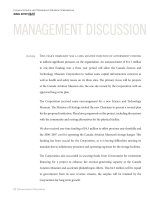advanced to pologies and technology
Bạn đang xem bản rút gọn của tài liệu. Xem và tải ngay bản đầy đủ của tài liệu tại đây (1.43 MB, 34 trang )
ECE 410, Prof. A. Mason Advanced Digital.1
CMOS Logic Families
• Many “families” of logic
exist beyond Static
CMOS
• Comparison of logic
families for a 2-input
multiplexer
• Briefly overview
–pseudo-nMOS
– differential (CVSL)
– dynamic/domino
– complementary pass-gate
ECE 410, Prof. A. Mason Advanced Digital.2
nMOS Inverter
•Logic Inverter
•nMOS Inverter
– assume a resistive load to VDD
– nMOS switches pull output low based on inputs
• Active loads
– use pMOS transistor in place of resistor
– resistance varies with Gate connection
•Ground Æ always on
• Drain=Output Æ turns off when Vout > VDD-Vtp
–V
SG
= V
SD
so always in saturation
• Vbias Æ can turn Vbias for needed switching characteristics
nMOS Inverter (a) nMOS is off,
(b) nMOS is on
x yxy
0
1
1
0
= x
Vbias
ECE 410, Prof. A. Mason Advanced Digital.3
Pseudo-nMOS
generic pseudo-nMOS logic gate
pseudo-nMOS
inverter
pseudo-nMOS NAND and NOR
• full nMOS logic array
• replace pMOS array with single pull
up transistor
• Ratioed Logic
– requires proper tx size ratios
•Advantages
– less load capacitance on input signals
• faster switching
– fewer transistors
• higher circuit density
•Disadvantage
– pull up is always on
• significant static power dissipation
–V
OL
> 0
ECE 410, Prof. A. Mason Advanced Digital.4
Pseudo nMOS DC Operation
• Output High Voltage, V
OH
(Maximum output)
– occurs when input is low (Vin = 0V), nMOS is OFF
– pMOS has very small V
SD
Æ triode operation
– pMOS pulls Vout to VDD
–V
OH
= VDD
• Output Low Voltage, V
OL
(Minimum output)
– occurs when input is high (Vin = VDD)
– both nMOS and pMOS are ON
• nMOS is “on stronger”; pulls Vout low
– as Vout goes low, nMOS enters triode
• continues to sink current from pMOS load
–V
OL
> 0 V (active load always pulling)
• Logic Swing (max output swing)
–V
L
= V
OH
-V
OL
< VDD
pseudo nMOS
inverter VTC
V
OH
= VDD
V
OL
> Ground
ECE 410, Prof. A. Mason Advanced Digital.5
Pseudo nMOS Transient Analysis
• Rise and Fall Times
– harder to analyze for pseudo nMOS
– due to “always on” active load
slow rise time
faster fall time
but does not fall to 0 volts
ECE 410, Prof. A. Mason Advanced Digital.6
Differential Logic
• Cascode Voltage Switch Logic (CVSL)
– aka, Differential Logic
• Performance advantage of ratioed
circuits without the extra power
• Requires complementary inputs
– produces complementary outputs
•Operation
– two nMOS arrays
•one for
f
, one for
f
–cross-coupled load pMOS
– one path is always active
• since either
f
or
f
is always true
– other path is turned off
• no static power
generic differential logic gate
differential AND/NAND gate
(logic arrays turns off one load)
ECE 410, Prof. A. Mason Advanced Digital.7
Differential Logic
• Advantages of CVSL
– low load capacitance on inputs
– no static power consumption
– automatic complementary functions
•Disadvantages
– requires complementary inputs
– more transistors
• for single function
• Very useful in some circuit
blocks where complementary
signals are generally needed
– interesting implementation in
adders
differential 4-input XOR/XNOR
ECE 410, Prof. A. Mason Advanced Digital.8
Dynamic Logic
• Advantages of ratioed logic without power consumption
of pseudo-nMOS or excess tx of differential
• Dynamic operation: output not always valid
• Precharge stage
– clock-gated pull-up precharges output high
– logic array disabled
• Evaluation stage
–prechargepull-up disabled
– logic array enabled & if true, discharges output
generic dynamic logic gate
ECE 410, Prof. A. Mason Advanced Digital.9
Dynamic Logic
• Example: Footed dynamic NAND3
• Footed vs. Unfooted
– foot tx ensures nMOS array disabled
during precharge
unfooted
footed
ECE 410, Prof. A. Mason Advanced Digital.10
Charge Redistribution in Dynamic Logic
• Major potential problem
– during evaluation, precharge charge is distributed over parasitic
capacitances within the nMOS array
• causes output to decrease (same charge over larger C Æ less V)
– if the function is not true, output should be HIGH but could be
much less than VDD
charge distribution over nMOS
parasitics during evaluation
• One possible solution
– “keeper” transistor
• injects charge during evaluation if
output should be HIGH
• keeps output at VDD
– keeper controlled by output_bar
• on when output is high
ECE 410, Prof. A. Mason Advanced Digital.11
Domino Logic
• Dynamic logic can only
drive
an output LOW
– output HIGH is precharged only with limited drive
• Domino logic adds and inverter buffer at output
• Cascading domino logic
– must alter precharge/eval cycles
– clock each stage on opposite
clock phase
generic domino logic gate
NP dynamic logic
NO RAce (NORA)
domino logic
ECE 410, Prof. A. Mason Advanced Digital.12
Pass Transistor (PT) Logic
A
B
F
B
0
A
0
B
B
= A • B
F
= A • B
Gate is static – a low-impedance path exists to both
supply rails under all circumstances
N transistors instead of 2N
No static power consumption
Ratioless
Bidirectional (versus undirectional)
ECE 410, Prof. A. Mason Advanced Digital.13
VTC of PT AND Gate
A
0
B
B
F
= A•B
1.2/0.6
1.2/0.6
1.2/0.6
2.4/0.6
0
1
2
012
B=V
DD
, A=0→V
DD
A=V
DD
, B=0→V
DD
A=B=0→V
DD
V
out
, V
V
i
n
,
V
z Pure PT logic is not regenerative - the signal
gradually degrades after passing through a number
of PTs (can fix with static CMOS inverter insertion)
ECE 410, Prof. A. Mason Advanced Digital.14
nMOS Only PT Driving an Inverter
•V
x
does not pull up to V
DD
, but V
DD
–V
Tn
In = V
DD
A = V
DD
V
x
=
V
DD
-V
Tn
M
1
M
2
B
SD
• Threshold voltage drop causes static power consumption (M
2
may be weakly conducting forming a path from V
DD
to GND)
•Notice V
Tn
increases of pass transistor due to body effect
(V
SB
)
V
GS
ECE 410, Prof. A. Mason Advanced Digital.15
Voltage Swing of PT Driving an Inverter
•Body effect–large V
SB
at x - when pulling high (B is tied to
GND and S charged up close to V
DD
)
• So the voltage drop is even worse
V
x
= V
DD
-(V
Tn0
+ γ(√(|2φ
f
| + V
x
) - √|2φ
f
|))
In = 0 → V
DD
V
DD
x
Out
0.5/0.25
0.5/0.25
1.5/0.25
0
1
2
3
00.511.52
Time, ns
Voltage, V
In
Out
x = 1.8V
D
S
B
ECE 410, Prof. A. Mason Advanced Digital.16
TG Full Adder
Sum
C
out
A
B
C
in
16 Transistors; full swing – transmission gates
ECE 410, Prof. A. Mason Advanced Digital.17
Basic CMOS Isolation Structures
• LOCOS –Local Oxidation of Silicon
• STI –Shallow Trench Isolation
• LDD –Lightly-Doped Drain
– Used to reduce the lateral electric field in the channel
• SOI –Silicon on Insulator
• BiCMOS -Bipolar and CMOS on same chip
ECE 410, Prof. A. Mason Advanced Digital.18
LOCOS
• Isolation between
transistor
– Field Oxide (FOX)
•FOX formed by
– masking active regions
– thermal oxidation of
non-masked areas
•Self-aligned gate
– S/D formed after
poly gate
– S/D automatically
aligned to gate
p+p+ p+
n
n+ n+ n+
p-type substrate
Layout view
Cross section view
FOX
ECE 410, Prof. A. Mason Advanced Digital.19
Problems with LOCOS
• Device “packing” density limited by “bird’s beak effect
of FOX isolation layer.
– effects the width (W) of the transistor
• Can improve density with Shallow Trench Isolation (STI)
bird’s beak
ECE 410, Prof. A. Mason Advanced Digital.20
Shallow Trench Isolation (STI)
• Form Gate and S/D first
•Then isolate devices by
– etching trench (~0.4um)
in substrate between
devices
– filling trench with
deposited oxide
• Eliminates the area lost
to bird’s beak effect of
LOCOS
• Well doping and channel
implants done later in
process via high energy
ion implantation
ECE 410, Prof. A. Mason Advanced Digital.21
Lightly-Doped Drain (LDD)
• Create lightly doped regions in S/D near the channel
• Necessary for submicron fabrication
– reduces the electric field across the channel
– reduces the velocity of electrons in the channel
(hot carrier effect)
– reduces performance, but allows higher density
• Can be used with any
isolation process
ECE 410, Prof. A. Mason Advanced Digital.22
Silicon On Insulator (SOI)
• Buried SiO
2
layer beneath
surface of active single-
crystal Si substrate
• More expensive, but
excellent isolation
– no leakage current to
substrate
–no latchup
– high transconductance
– good subthreshold
performance
– reduced short channel
effects
– radiation immunity
ECE 410, Prof. A. Mason Advanced Digital.23
BiCMOS
•Advantage
– both Bipolar and CMOS transistor
•Disadvantage
– Increased process complexity
– Reduced density (just no way to make small BJTs)
ECE 410, Prof. A. Mason Advanced Digital.24
Scaling Options
• Constant Voltage (CV)
– voltage remains constant as feature size is reduced
– causes electric field in channel to increase
• decreases performance
– but, device will fail if electric field gets too large
• Constant Electric Field (CE)
– scale down voltage with feature size
– keeps electric field constant
• maintain good performance
– but, limit to how low voltage can go
Electric Field in channel
vs. Channel Length
at various Supply Voltages
constant electric field
constant
voltage
ECE 410, Prof. A. Mason Advanced Digital.25
Low Voltage Issues
• Reasons modern/future circuits have lower voltage
– lower voltage = lower dynamic power: P
dyn
= α C
L
V
DD
2
f
CLK
– lower voltage required for smaller feature size
• feature sizes reduced to improve performance/speed
• smaller features = shorter distances across the channel
Î stronger electric fields in channel
Î poorer performance or device failure
»unless
voltage is reduced also
• Side effects of reducing voltage
– reduces current (speed) and increases noise problems
– as supply voltage decreases, must also reduce threshold voltage
• otherwise, circuits will not switch correctly
– reduced threshold voltage = increased subthreshold current
Î increased leakage currents
Î increased static power consumption









